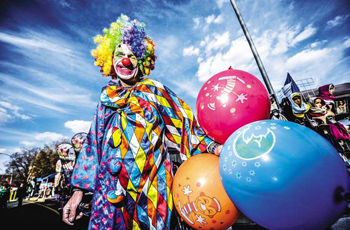 Photo: Conrad Bornman |
It is the dead of winter in the heart of the Free State. The Vryfees is laying full steam ahead.
However, the talent that makes of this annual arts festival such a phenomenal success doesn’t only come from outside of our Bloemfontein Campus. This year’s productions will abound with performances by Kovsie staff, students and alumni from our Department of Drama and Theatre Arts.
Behind the scenes, our people will also play a vital role in the achievement and progress of the festival. Prof Luwes is a member of the festival committee and together with Dr Venter and Godfrey Manenye, he also serves on the artistic selection committee for theatre.
Thys Heydenrych, lecturer in the above department, was appointed as the technical manager of this year’s Vryfees. This means that he is in charge of the placement and assigning of venues for productions on campus. All the technical aspects for these venues rest on Heydenrych’s shoulders. For this huge task, he is supported by a team of technical staff which includes mostly students.
Take a look at the list of all our Kovsie artists who are working hard to make the 2014 Vryfees better than ever:
Don Juan onder die Boere Lecturers: Walter Strydom, Gerben Kamper (director),
Students: Mark Dobson, Michael Garbett, Helet de Wet
Former students: Marijda Kamper (Wynand Mouton theatre manager), Ilne Fourie, Hilletje Möller, Chanmari Erasmus, Michelle Hoffman, An-Mari Loots, Madré van Straten
S(t)out en Peper Lecturers: Dr Pieter Venter (director), Thys Heydenrych
Former students: Ilne Fourie, Michelle Hoffman
Nag van die Hiëna Head of Department: Prof Nico Luwes (author and director)
Lecturers: Gerben Kamper, Minette Grové
Former students: Carel Nel, Lindy-Lee Kleynhans, Ilne Fourie, Angelo Mockie (staff member at Student Affairs)
Student: Peter Taljaard (PhD student)
Rondomskrik Former student: Chrystal-Donna Roberts (currently Pasella presenter and previously on the set of 7de Laan)
Slaaf Former student: Carel Nel
Te Veel vir ? Coloured Girl Former students: Angelo Mockie (staff member at Student Affairs), Olivie Sauer
The Bar Lecturer: Godfrey Manenye (director)
Former students: Angela Edwards, Jane Mpholo
Students: Yoliswa Jacobs and Luandro Carstens
Victoria se Geheim Lecturer: Dr Pieter Venter (director)
Former students: Chanmari Erasmus, Carel Nel, Gené McCaskill, Michelle Hetzel
Students: Helet de Wet, Marli van der Bijl (NRF Magister Intern), Jana Coetzer, Marnel Bester
Een Kleine Lientjie Lecturer: Walter Strydom
Former student: Anna Visser (author and director, OFM presenter)
Students: Marli van der Bijl, Charl Henning, Jana Coetzer
For more information on the productions or the Vryfees programme, follow this link:
http://www.vryfees.co.za/